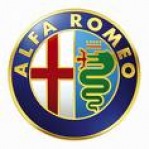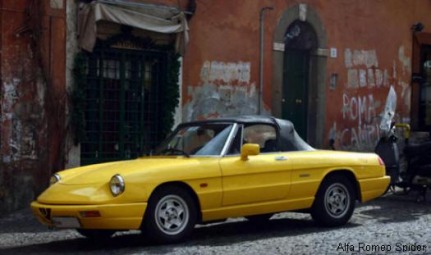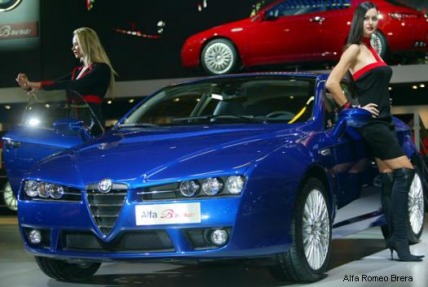Alfa Romeo-History

Past to Present
The company that is known today as Alfa Romeo, was established by Cavaliere Ugo Stella in 1907. Stella was from Milan's aristocracy. At the time the Company began, he initiated a partnership with Alexandre Darrcq, a French firm. When the partnership fell through, Stella and his fellow Italian investors moved production to a factory in Portello, a Milan suburb. It was at that time that the Company's name was changed to ALFA.
In 1910, ALFA produced the first non-Darracq car. It was designed by Giuseppe Merosi and was named the 24HP for the power that it produced. Merosi went on to design a series of powerful ALFA automobiles, the 40 and 60HP. The Company then entered the auto racing circuit. In 1911, drivers Ranzoni and Franchini drove ALFAs at the Targa Florio.
War
When WWI broke out, it stopped ALFA's production for three years. ALFA fell under the direction of Nicholo Romeo, a Neopolitan entrepreneur. He revamped the factory to produce military hardware for the Allied and Italian war effort. During the war years, ALFA made aircraft engines and components, compressors, generators, heavy locomotives and munitions. Many of the wartime products were based on the existing engines that ALFA had built before the war.
Romeo took complete control of ALFA when WWI ended. By 1919, car production had resumed.
The name of the Company was changed from ALFA to Alfa Romeo in 1920. The first car produced under the new name was the Torpedo 20-30HP. The Company's head designer was still Giuseppe Merosi. Alfa Romeo produced both racing and road cars such as the RL Targa Florio and the 40-60HP.
New Chief Designer
In 1923, Giuseppe Merosi was replaced as chief designer by Vittorio Jano, who was lured away from Fiat by Alfa Romeo driver, Enzo Ferrari. The first Alfa Romeo designed by Jano was the P2 Grand Prix. In 1925, it won the World Championship for the Company.
Series
Jano developed a series of road cars for Alfa Romeo with small to medium displacement. They were based on the P2 engine and had 4, 6 and 8 inline power plants. The construction was light alloy, they had centrally located plugs, hemispherical combustion chambers, dual overhead cams and two rows of overhead valves on each cylinder bank. Jano always designed powerful and reliable cars.
Problems at Alfa Romeo
When defense contracts ended in 1928, the Company went broke. Nicholo Romeo left the Company. The government took control and in 1933, rescued Alfa Romeo. At that time Alfa became a national emblem of Mussolini's Italy.
World War II
During WWII, the factory of Alfa Romeo was completely bombed out. After the war, the Company struggled to survive. Luxury vehicles were sold out and replaced by mass produced vehicles that were smaller. The Company was then able to get back on solid financial ground.
More Financial Woes
The 1970's saw Alfa Romeo in dire financial straits once more. When Fiat bought into the Company in 1986, the Italian government ceased to give financial assistance. A new group, Alfa Lancia Spa was formed. It would produce both Alfas and Lancias.
Alfa Racing History
Many prestigious wins have been recorded by Alfa Romeo in Touring, Fast Touring, Prototypes and Formula 1. Some fantastic victories have also been won by private drivers in rally competition.
The Alfa Romeo Badge
Romano Cattaneo was put in charge of designing a badge for Milan based ALFA in 1910. He was inspired, so the story goes, by the red cross and coat of arms of the Visconti family. He recruited designer Giuseppe Merosi to help him with the creation. Sketches included both the emblem of the Visconti family and that of the City of Milan. They were encased in a circular motif. The border was a ring of dark metallic blue. Included were the ALFA and MILANO names. They were separated by two Savoy dynasty knots, which were replaced by two wavy knots in 1946. The logo was changed again in 1972 when the word MILANO was dropped. The two Milanese symbols remained beneath the Alfa Romeo name.
Emergency Vehicles
Through the years, Alfa Romeo cars have been used by police to chase and apprehend criminals. Italy, Malaysia and Switzerland found that the Giulia 1.6 was a great law enforcement car. Italy replaced the Giulia 1.6 with the Giulietta and in the 1980s, with the 75.
Prestige
Alfa Romeo has long been an automobile of prestige. In the 1980s, movie star Liza Minelli traveled to Italy for a series of concerts. She arrived in an Alfa Romeo "90.â€Â
Alfa Romeo Today
Alfa Romeo continues to produce high quality passenger cars. As well, the Alfa Team chalks up victories at the racetrack. If you are in the area of Artese, and would like to learn more about Alfa Romeo history, be sure to visit the AlfaRomeoMuseum.
ALFA ROMEO TO RETURN TO THE USA
The Italian sports carmaker Alfa Romeo will return to the United States market in the not too distant future, Fiat CEO Sergio Marchionne confirmed here on Wednesday. The Italian sports car's return to the lucrative market, which it abandoned in 1995, "will take place through Maserati's sales and service network once we have obtained all the necessary authorization from American authorities," he added. Fiat, which has owned Alfa Romeo since 1986, decided in February of last year to create a new luxury sports car unit through a Maserati-Alfa Romeo alliance. Speaking at the time, Marchionne explained that "Maserati has made giant steps over the past few years but it needs a greater volume in sales. A technological and sales alliance with Alfa Romeo will allow it to reduce production costs". "Maserati and Alfa Romeo can complement each other from both a market and industrial point of view. What we must decide now is which dealerships can offer both marques... with the medium-term goal of bring Alfa Romeo back to the United States," he added. Fiat initially acquired financially-troubled Maserati in 1997 through Ferrari but later decided it was best to link it up with Alfa Romeo. This became financially feasible after Fiat and General Motors of the United States agreed at the start of 2005 to end their master agreement, after five years of industrial cooperation, in a deal which put $2 billion into Fiat's pocket. The consensus at the time was that teaming Alfa Romeo up with Maserati and letting Ferrari stand alone would bring benefits for all parties involved. Ferrari would benefit because it would be free of the debt Maserati brought with it and thus in a better position for its much announced and constantly postponed step towards the stock market, originally planned for 2002. Maserati, on the other hand, would benefit from using Alfa's less expensive component parts to produce more accessible models, including the popular SUVs which rivals Audi, BMW and Mercedes are already producing. For Alfa Romeo, an alliance with Maserati would give it access to its research and development and pave the way for a return to the lucrative American market, where it could rely on Maserati's well-established sales and service networks.


